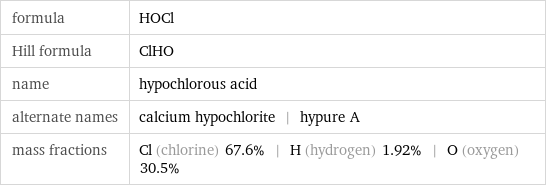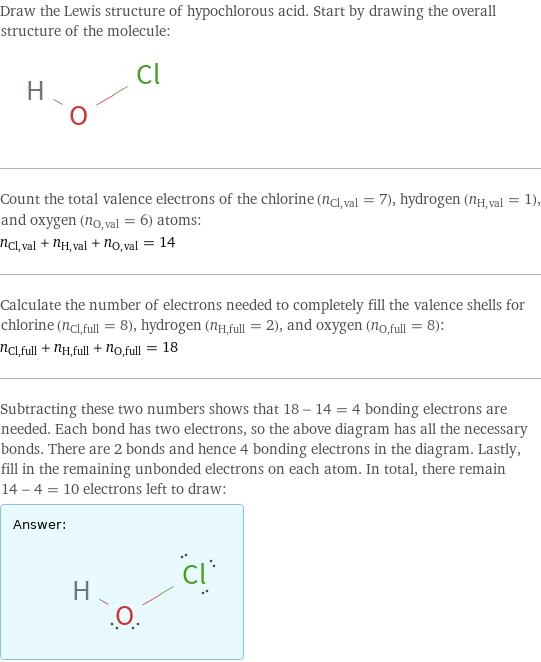Input interpretation

hypochlorous acid
Chemical names and formulas

formula | HOCl Hill formula | ClHO name | hypochlorous acid alternate names | calcium hypochlorite | hypure A mass fractions | Cl (chlorine) 67.6% | H (hydrogen) 1.92% | O (oxygen) 30.5%
Lewis structure

Draw the Lewis structure of hypochlorous acid. Start by drawing the overall structure of the molecule: Count the total valence electrons of the chlorine (n_Cl, val = 7), hydrogen (n_H, val = 1), and oxygen (n_O, val = 6) atoms: n_Cl, val + n_H, val + n_O, val = 14 Calculate the number of electrons needed to completely fill the valence shells for chlorine (n_Cl, full = 8), hydrogen (n_H, full = 2), and oxygen (n_O, full = 8): n_Cl, full + n_H, full + n_O, full = 18 Subtracting these two numbers shows that 18 - 14 = 4 bonding electrons are needed. Each bond has two electrons, so the above diagram has all the necessary bonds. There are 2 bonds and hence 4 bonding electrons in the diagram. Lastly, fill in the remaining unbonded electrons on each atom. In total, there remain 14 - 4 = 10 electrons left to draw: Answer: | |
3D structure

3D structure
Basic properties

molar mass | 52.46 g/mol solubility in water | soluble
Units

Thermodynamic properties

specific heat capacity c_p | gas | 0.7092 J/(g K) molar heat capacity c_p | gas | 37.2 J/(mol K) specific free energy of formation Δ_fG° | gas | -1.26 kJ/g molar free energy of formation Δ_fG° | gas | -66.1 kJ/mol specific heat of formation Δ_fH° | gas | -1.5 kJ/g molar heat of formation Δ_fH° | gas | -78.7 kJ/mol (at STP)
Chemical identifiers

CAS number | 7790-92-3 PubChem CID number | 24341 SMILES identifier | OCl InChI identifier | InChI=1/ClHO/c1-2/h2H EU number | 232-232-5 Gmelin number | 688 RTECS number | NH3470000 NSC number | 21546
Toxicity properties

RTECS classes | reproductive effector